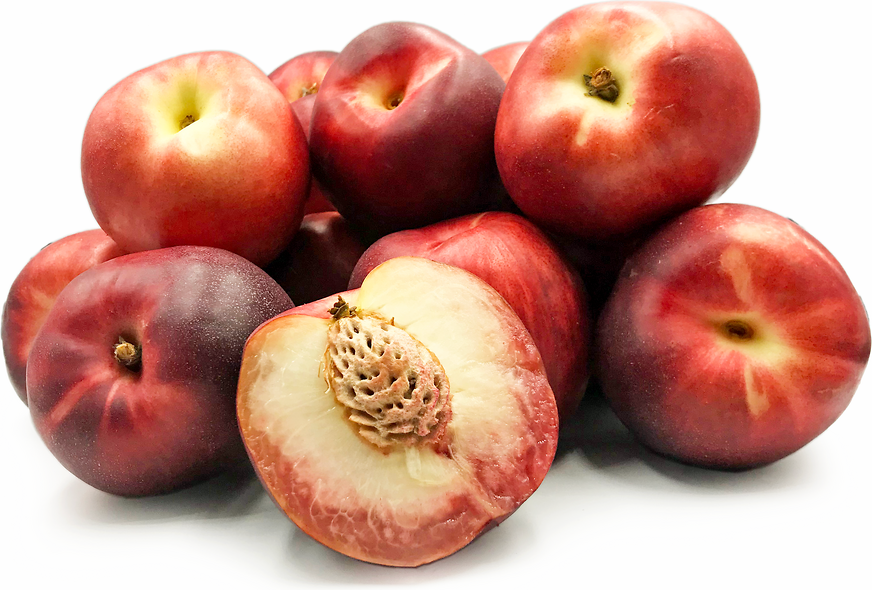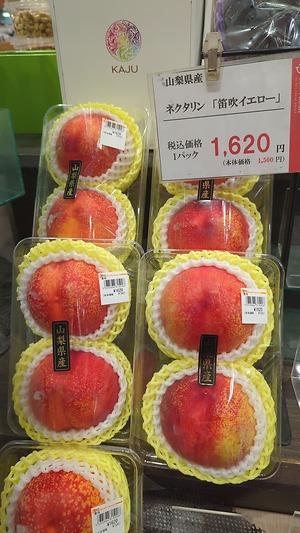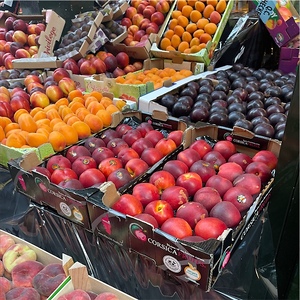


Corsica Nectarines
Estimated Inventory, lb : 0
Description/Taste
Corsica nectarines are small to medium in size and have a globular shape with a slight depression around the stem. The skin is smooth, taut, and golden yellow blushed with large, varying spots of light and dark red. Underneath the thin skin, the flesh is soft but firm, aqueous, and succulent. The flesh is also pale yellow-white with a light red-pink border just below the surface and encases a central, inedible stone that is easily removed and does not cling to the flesh. When transitioning from immature to ripe, the fruits will not change in color, but the flesh will soften and bear a distinct, fruity aroma. Corsica nectarines are juicy and tender with a light and sweet flavor.
Seasons/Availability
Corsica nectarines are available in the summer through fall in Europe.
Current Facts
Corsica nectarines, botanically classified as Prunus persica, are small fruits that grow on deciduous, leafy trees and are members of the Rosaceae family. Believed to be a spontaneous, fuzz-less variety descended from a peach, nectarines are favored for their sweet taste and juicy consistency. Corsica nectarines are native to and named after the small French island in the Mediterranean, and along with peaches, the nectarines are one of the most popular fruits found on the island, predominately consumed fresh as a sweet snack.
Nutritional Value
Corsica nectarines are an excellent source of vitamins A and C, which can help keep tissues in the body healthy and boost the immune system. The fruit also contains some potassium and beta-carotene.
Applications
Corsica nectarines are best suited for both raw and cooked applications such as baking. The fruits are popularly consumed fresh, out-of-hand as a summer snack and can be eaten with the skin on or removed. Corsica nectarines can also be sliced and tossed into salads, layered in crepes, used as a topping over ice cream, or served as a garnish. When cooked, the fruits are made into compotes, jams, and preserves, blended with ice to make sorbet, or baked into cobblers, pies, and tarts. In France, nectarines are utilized in the famous desert known as nectarine clafoutis, which is a custard-like cake topped with the fruit. Corsica nectarines pair well with caramel, cinnamon, vanilla, hazelnuts, almonds, basil, mint, ginger, lime, coconut, blueberries, figs, and cherries. The fruits should be kept at room temperature until ripe, and once mature, they will keep for one week when stored in the refrigerator.
Ethnic/Cultural Info
Corsica is a small French island in the Mediterranean that is known for its diverse terrain, outdoor activities, and natural, raw food scene. Produce cultivation on the island is focused around ethically sourced ingredients and reducing waste, and many of the fruits and vegetables grown have earned a reputation in Europe for being high quality and rich in flavor. Corsica cultivates over thirty different types of produce, including peaches, nectarines, lettuce, peppers, cucumbers, figs, and grapes, and many of these items are consumed fresh during the summer months. In addition to producing high-quality produce, it is common for locals to consume three-course lunches using the local, fresh flavors with fruits, vegetables, cheeses, cured meats, and seafood.
Geography/History
Nectarines are believed to be a spontaneous mutation of peaches and were thought to have originated in China. The fuzz-less fruit was then spread via trade routes across Asia into Europe and cultivation began in Europe in the 16th-17th centuries. The specific origins of Corsica nectarines are mostly unknown, but today the fruit is still grown on the French island in the Mediterranean and is exported on a small scale to select specialty grocers and markets in Europe.










